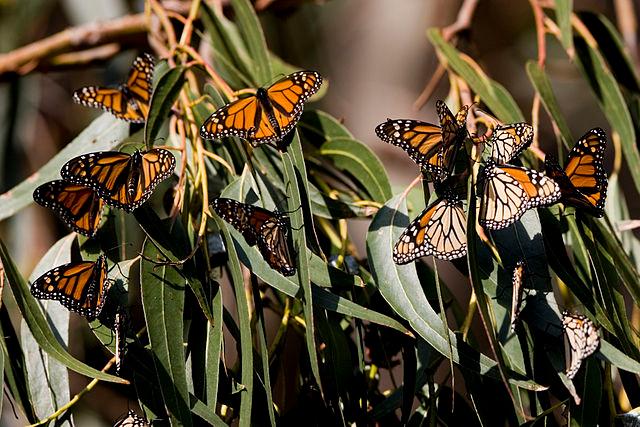Monarch butterflies threatened by loss of habitat
Monarch butterflies migrate 2,000 miles every year in the winter to Mexico. (Photo by Mike Baird via Wikimedia Commons).
A new study conducted by Mexico’s National Commission of Natural Protected Areas shows that the number of monarch butterflies migrating in the winter to the mountaintops of Mexico declined 59 percent this year.
But one ecologist suggests that the declining monarch population could be an indicator of how well certain habitats are maintained.
Chip Taylor, founder of Monarch Watch and professor of ecology and evolutionary biology at the University of Kansas–Lawrence, says the overwinter population numbers were surprising, but he is thankful the numbers were not even lower.
The population is measured in hectors, and this year there were 1.19 hectors of butterflies that migrated to Mexico for the winter. In acre terms, this means there were about 2.74 acres for the total area of trees occupied by these butterflies, Taylor says.
Scientists attribute declining monarch numbers to the significant loss of the monarch’s milkweed habitat throughout the Midwest due to the increase of corn and soybean farming. Milkweed is essential for the survival of monarchs because it is their primary food source and breeding ground.
“There was a small amount of milkweed that survived tillers that went on to eliminate weeds in those fields. But now they’re using chemicals to eliminate the weeds and they have eliminated milkweed,” Taylor says. “We’ve also had this big push to develop biofuels and that’s consumed a lot of monarch habitat.”
Unusual weather events can also be a factor, Taylor says, because monarchs do not adapt to drought and extremely high temperatures well, causing lower monarch reproduction rates.
But the plight of the monarch has not gone unnoticed. A new IMAX documentary, “Flight of the Butterflies,” follows the story of Fred and Nora Urquhart and their 40-year journey tracking the monarch’s migration to Mexico.
Through their journey, the Urquharts created a citizen scientist program of thousands of volunteers who tagged butterflies. And Taylor hopes to tap into the citizen scientist resource by encouraging people to create “monarch waystations” by planting milkweed in butterfly gardens.
“These butterflies share the same habitat with a lot of other organisms and if we’re losing these butterflies, we’re losing habitats for a lot of the pollinators out there,” Taylor says.
Pollinators are essential for ecological services because they pollinate about 70 percent of vegetation and are needed to produce fruits, nuts and berries to feed other species.
“Monarchs are simply an indication that we’re not doing very well maintaining those marginal habitats that support all those species,” Taylor says.
